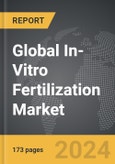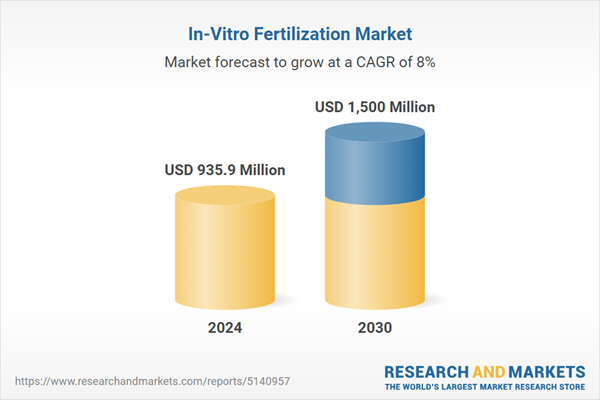Global In-Vitro Fertilization Market - Key Trends & Drivers Summarized
What Is Driving the Expansion of In-Vitro Fertilization Services Worldwide?
In-vitro fertilization (IVF) has emerged as a critical solution for couples facing infertility, leading to its widespread adoption across the globe. The demand for IVF services is being propelled by various factors, including delayed childbearing due to career priorities, lifestyle changes, and the rising prevalence of fertility-related disorders. Additionally, social acceptance of assisted reproductive technologies (ART) has grown, aided by advancements in medical science and supportive government policies in several countries. With increasing awareness and access to fertility treatments, more individuals and couples are turning to IVF as a viable option for starting a family. This growth is further supported by the availability of financing options and insurance coverage in certain regions, making IVF more accessible to a broader demographic.How Are Technological Innovations Shaping the Future of IVF?
Technological advancements are revolutionizing the IVF market, leading to higher success rates and improved patient outcomes. Innovations such as preimplantation genetic testing (PGT), time-lapse imaging, and artificial intelligence (AI)-driven embryo selection are enhancing the accuracy and efficiency of the IVF process. These technologies allow for the selection of the healthiest embryos, reducing the risk of genetic disorders and increasing the likelihood of successful pregnancies. Additionally, the development of cryopreservation techniques has enabled the storage of embryos, eggs, and sperm for extended periods, offering greater flexibility to patients. The integration of telemedicine and digital platforms is also facilitating remote consultations and monitoring, making IVF treatments more convenient and accessible, particularly in regions with limited access to fertility clinics.Why Are Ethical and Regulatory Considerations Central to the Growth of IVF?
Ethical and regulatory considerations play a crucial role in the growth and acceptance of IVF services. Different countries have varying regulations governing the use of ART, impacting how IVF is practiced and accessed globally. For instance, some regions have restrictions on the use of donor eggs or embryos, while others may regulate the number of embryos that can be implanted or preserved. These regulations are designed to address ethical concerns related to the potential for multiple births, the use of surplus embryos, and the implications of genetic testing. As IVF technologies continue to evolve, the regulatory landscape must adapt to ensure that these advancements are used responsibly and ethically. Compliance with these regulations is essential for clinics to operate legally and maintain public trust in their services.What Factors Are Driving Growth in the IVF Market?
The growth in the in-vitro fertilization (IVF) market is driven by several factors, including the increasing prevalence of infertility, advancements in reproductive technologies, and the expansion of fertility clinics worldwide. The rising number of women opting to delay pregnancy due to career or personal reasons has also contributed to the demand for IVF services. Additionally, societal shifts, such as the growing acceptance of same-sex couples and single parents seeking fertility treatments, have expanded the market. The availability of government support and favorable reimbursement policies in certain regions further encourages the adoption of IVF. Furthermore, technological innovations that improve success rates, such as AI in embryo selection and advanced genetic screening techniques, are propelling the market forward by offering patients better outcomes and more personalized treatment options.Report Scope
The report analyzes the In-Vitro Fertilization market, presented in terms of market value (USD). The analysis covers the key segments and geographic regions outlined below.- Segments: Offering (Equipment, Reagents & Media, Accessories); End-Use (Fertility Clinics, Hospitals & Surgical Centers, Other End-Uses).
- Geographic Regions/Countries: World; United States; Canada; Japan; China; Europe (France; Germany; Italy; United Kingdom; Spain; Russia; and Rest of Europe); Asia-Pacific (Australia; India; South Korea; and Rest of Asia-Pacific); Latin America (Argentina; Brazil; Mexico; and Rest of Latin America); Middle East (Iran; Israel; Saudi Arabia; United Arab Emirates; and Rest of Middle East); and Africa.
Key Insights:
- Market Growth: Understand the significant growth trajectory of the IVF Equipment segment, which is expected to reach US$684.2 Million by 2030 with a CAGR of 7.7%. The IVF Reagents & Media segment is also set to grow at 9.1% CAGR over the analysis period.
- Regional Analysis: Gain insights into the U.S. market, valued at $241.7 Million in 2024, and China, forecasted to grow at an impressive 11.7% CAGR to reach $368.1 Million by 2030. Discover growth trends in other key regions, including Japan, Canada, Germany, and the Asia-Pacific.
Why You Should Buy This Report:
- Detailed Market Analysis: Access a thorough analysis of the Global In-Vitro Fertilization Market, covering all major geographic regions and market segments.
- Competitive Insights: Get an overview of the competitive landscape, including the market presence of major players across different geographies.
- Future Trends and Drivers: Understand the key trends and drivers shaping the future of the Global In-Vitro Fertilization Market.
- Actionable Insights: Benefit from actionable insights that can help you identify new revenue opportunities and make strategic business decisions.
Key Questions Answered:
- How is the Global In-Vitro Fertilization Market expected to evolve by 2030?
- What are the main drivers and restraints affecting the market?
- Which market segments will grow the most over the forecast period?
- How will market shares for different regions and segments change by 2030?
- Who are the leading players in the market, and what are their prospects?
Report Features:
- Comprehensive Market Data: Independent analysis of annual sales and market forecasts in US$ Million from 2024 to 2030.
- In-Depth Regional Analysis: Detailed insights into key markets, including the U.S., China, Japan, Canada, Europe, Asia-Pacific, Latin America, Middle East, and Africa.
- Company Profiles: Coverage of players such as Cook Medical, Inc., CooperSurgical, Inc., EMD Serono, Inc., Esco Micro Pte. Ltd., Genea Limited and more.
- Complimentary Updates: Receive free report updates for one year to keep you informed of the latest market developments.
Some of the 42 companies featured in this In-Vitro Fertilization market report include:
- Cook Medical, Inc.
- CooperSurgical, Inc.
- EMD Serono, Inc.
- Esco Micro Pte. Ltd.
- Genea Limited
- Irvine Scientific
- Ivftech Aps
- KITAZATO CORPORATION
- Rocket Medical PLC
- The Baker Company, Inc.
- Thermo Fisher Scientific, Inc.
- Vitrolife AB
This edition integrates the latest global trade and economic shifts into comprehensive market analysis. Key updates include:
- Tariff and Trade Impact: Insights into global tariff negotiations across 180+ countries, with analysis of supply chain turbulence, sourcing disruptions, and geographic realignment. Special focus on 2025 as a pivotal year for trade tensions, including updated perspectives on the Trump-era tariffs.
- Adjusted Forecasts and Analytics: Revised global and regional market forecasts through 2030, incorporating tariff effects, economic uncertainty, and structural changes in globalization. Includes historical analysis from 2015 to 2023.
- Strategic Market Dynamics: Evaluation of revised market prospects, regional outlooks, and key economic indicators such as population and urbanization trends.
- Innovation & Technology Trends: Latest developments in product and process innovation, emerging technologies, and key industry drivers shaping the competitive landscape.
- Competitive Intelligence: Updated global market share estimates for 2025, competitive positioning of major players (Strong/Active/Niche/Trivial), and refined focus on leading global brands and core players.
- Expert Insight & Commentary: Strategic analysis from economists, trade experts, and domain specialists to contextualize market shifts and identify emerging opportunities.
Table of Contents
Companies Mentioned (Partial List)
A selection of companies mentioned in this report includes, but is not limited to:
- Cook Medical, Inc.
- CooperSurgical, Inc.
- EMD Serono, Inc.
- Esco Micro Pte. Ltd.
- Genea Limited
- Irvine Scientific
- Ivftech Aps
- KITAZATO CORPORATION
- Rocket Medical PLC
- The Baker Company, Inc.
- Thermo Fisher Scientific, Inc.
- Vitrolife AB
Table Information
| Report Attribute | Details |
|---|---|
| No. of Pages | 173 |
| Published | November 2025 |
| Forecast Period | 2024 - 2030 |
| Estimated Market Value ( USD | $ 935.9 Million |
| Forecasted Market Value ( USD | $ 1500 Million |
| Compound Annual Growth Rate | 8.0% |
| Regions Covered | Global |









